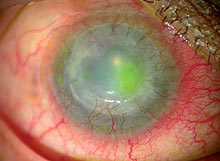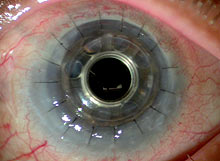State of the art: Keratoprosthesis an option in patients with failed corneal transplants
Anthony J. Aldave, MD, explains the development of the device and the latest advances.
Click Here to Manage Email Alerts
 John A. Hovanesian |
John A. Hovanesian, MD, FACS: Today we are joined by Anthony J. Aldave, MD, associate professor of ophthalmology and director of the cornea and external ocular disease division at the UCLA Jules Stein Eye Institute in Los Angeles. Dr. Aldave has extensive experience with the Boston keratoprosthesis. Dr. Aldave, thanks for joining us.
Anthony J. Aldave, MD: My pleasure. Thank you.
Dr. Hovanesian: Tell us why we are seeing increased use of keratoprostheses in corneal surgery.
Dr. Aldave: I think that it is due to the work primarily of Claes H. Dohlman, MD, PhD, who has tirelessly worked on the design of the Boston keratoprosthesis and now has a model that achieves remarkable clinical results, combined with the evolution of the surgical technique and the postoperative management.

Dr. Hovanesian: Tell us how the keratoprosthesis was developed.
Dr. Aldave: The Boston keratoprosthesis, which was formerly known as the Dohlman-Doane keratoprosthesis, was developed over a period of several decades. The original model obtained 510(k) clearance by the U.S. Food and Drug Administration in 1992. The original device, however, was associated with not an insignificant number of complications after surgery, and it was not until the device was modified in the late 1990s that many of the complications became much less common. It continues to evolve even today, however, so that when we present courses at various meetings regarding how to implant the device, we are constantly having to change our surgical videos as the device design and its assembly continue to evolve.
Dr. Hovanesian: What was the major design modification that allowed greater success with the more modern device?
Dr. Aldave: I think it would have to be the placement of holes in the back plate of the Boston keratoprosthesis. The keratoprosthesis consists of a front plate attached to an optic and a back plate that is secured to the optic. Previous designs included a solid back plate that limited access of aqueous to the corneal stroma, with a rate of corneal stromal necrosis that was unacceptably high. With the placement of holes in the back plate, allowing greater access of aqueous to the stroma, the incidence of melting of the donor cornea that carries the keratoprosthesis is now less than 10%.
 |  |
| Slit lamp photomicrograph of a patient with two failed corneal transplants and persistent corneal epithelial defect secondary to corneal limbal stem cell deficiency. Four years after keratoprosthesis implantation, the patient’s visual acuity is 20/30. Images: Aldave AJ | |
Dr. Hovanesian: Who are the best candidates for surgery?
Dr. Aldave: Traditionally it has been patients who have had two or more failed corneal transplants and, of course, are therefore likely to have a repeat corneal transplant failure. However, many surgeons, including myself, are implanting the device in patients who have coexistent corneal opacification and limbal stem cell deficiency, even if they have not had a previous corneal transplant. Typically, patients who are considered the best candidates are those who have poor vision in the contralateral eye, as well as those who have meaningful visual potential in the eye to be operated upon.
Dr. Hovanesian: What do our results look like with these devices?
Dr. Aldave: The best data that we have is from a multicenter study organized by Michael W. Belin, MD, in Albany, N.Y., that has collected data on Boston keratoprosthesis cases performed after Jan. 1, 2003, from approximately 21 sites across the country. At present, data has been collected on more than 300 surgeries, and we are finding that the retention rate is approximately 92% with average follow-up of more than 13 months. More than one-half of the patients obtain a visual acuity of 20/100 or better after surgery, which is remarkable considering that 85% to 90% of patients have preoperative visual acuities of counting fingers or worse.
Dr. Hovanesian: Are there complications and challenges that are unique to the keratoprosthesis?
Dr. Aldave: There certainly are. Approximately one-third of patients develop a retroprosthetic membrane, which is typically an avascular, although sometimes vascularized, membrane that can develop posterior to the optic of the keratoprosthesis and impair the vision, much as posterior capsular opacification can develop after cataract surgery. But as is the case with posterior capsular opacification, a YAG laser can usually be used to make an opening in the membrane and restore clarity of vision.
Other complications such as infectious keratitis or necrosis of the donor cornea, albeit rare, have been reported and may develop. While endophthalmitis was a problem in the 1990s with the Boston keratoprosthesis, we are now seeing a very low rate of endophthalmitis, likely due to the lifelong use of prophylactic topical antibiotics.
Dr. Hovanesian: How do we measure IOP in these patients, many of whom have coexisting glaucoma?
Dr. Aldave: That is a good question. Obviously, performing applanation tonometry is not possible over the keratoprosthesis, which is made out of PMMA. In my practice, we typically use two different techniques, one of which is to use finger tension through the closed eyelids, and the other of which is a handheld device that measures IOP through the upper eyelid over the superior limbus. Other surgeons will use a handheld device, such as a Tono-Pen (Reichert), over the limbus to measure IOP. It should be remembered, however, that after restoration of a clear cornea, we are able to monitor glaucoma development and progression with direct visualization of the optic nerve and serial visual field examinations.
Dr. Hovanesian: Finally, what advice would you give to the comprehensive ophthalmologist about the application of these devices to patients that he or she may have?
Dr. Aldave: I would say that if any ophthalmologist has a patient in their practice who has had one or more failed corneal transplants, they should consider a Boston keratoprosthesis for that patient. Although traditionally keratoprostheses have been reserved for patients who have poor vision in the contralateral eye, approximately 30% of the patients for whom I have performed this procedure have vision greater than or equal to 20/50 in the contralateral eye. Three-quarters of these patients obtained vision greater than 20/100 in the operative eye with an improved level of visual functioning after implantation of the Boston keratoprosthesis. If a comprehensive ophthalmologist has any questions regarding candidacy for surgery, consultation with an experienced keratoprosthesis surgeon is recommended.
Dr. Hovanesian: Dr. Aldave, thank you very much.
For more information:
- Anthony J. Aldave, MD, can be reached at Jules Stein Eye Institute, 100 Stein Plaza, UCLA, Los Angeles, CA 90095; 310-825-2737; fax: 310-794-7906; e-mail: aldave@jsei.ucla.edu. Dr. Aldave has no financial interests in any of the products mentioned in this article.
- John A. Hovanesian, MD, FACS, is a clinical instructor at the UCLA Jules Stein Eye Institute and is in private practice in Laguna Hills, Calif. He can be reached at Harvard Eye Associates, 24401 Calle De La Louisa, Suite 300, Laguna Hills, CA 92653; 949-951-2020; fax: 949-380-7856; e-mail: drhovanesian@harvardeye.com. Dr. Hovanesian has no financial interests in any of the products mentioned in this article.
